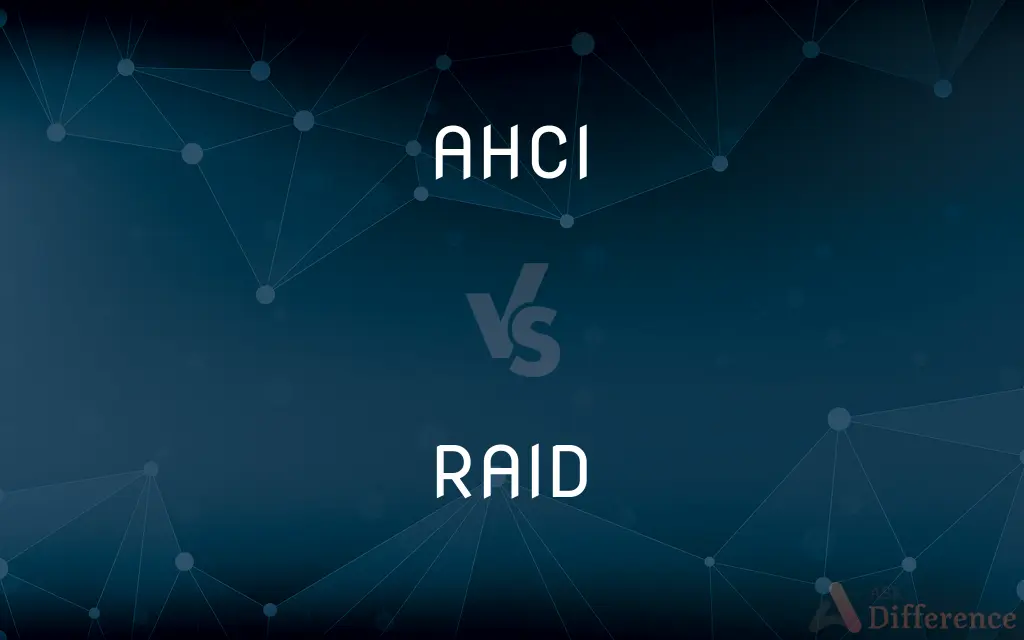AHCI vs. RAID — What's the Difference?
By Tayyaba Rehman & Fiza Rafique — Published on February 1, 2024
AHCI is a hardware mechanism for SATA devices to enable advanced features like hot-swapping and NCQ, while RAID is a storage technology that combines multiple disks into one unit for redundancy or performance.

Difference Between AHCI and RAID
Table of Contents
ADVERTISEMENT
Key Differences
AHCI, standing for Advanced Host Controller Interface, is a specification designed by Intel to describe the operation of SATA host controllers. It provides a standard method for software to communicate with SATA devices, offering features such as native command queuing and hot swapping. RAID, which stands for Redundant Array of Independent Disks, is a technology that combines multiple physical disk drives into a single logical unit for the purposes of data redundancy, performance improvement, or both. It is a way to store the same data in different places on multiple hard disks to protect data in the case of a drive failure.
While AHCI focuses on the interface between the system and SATA devices, providing a more efficient way of data transfer through features like NCQ, RAID is concerned with data storage strategies that improve performance and reliability. AHCI is a single standard, whereas RAID can be implemented in various configurations, each with its own specific goals and methods for achieving redundancy and performance enhancements.
AHCI enables capabilities such as hot swapping and native command queuing, which can improve performance in multi-tasking environments by allowing the hard drive to decide the order in which to execute read and write requests. RAID, on the other hand, can be set up in different levels, each offering a different balance of performance, data availability, and storage capacity. For instance, RAID 1 mirrors data across disks, RAID 0 stripes data for performance, and RAID 5 provides distributed parity for a balance of speed and redundancy.
The choice between AHCI and RAID depends on the user's needs: AHCI is typically used when the user requires advanced SATA features without the need for redundancy or performance enhancements provided by RAID configurations. RAID is chosen when data redundancy or performance (through striping) is a priority, making it a common choice for servers and systems where data availability is critical.
In terms of compatibility and setup, AHCI is generally supported out of the box by modern operating systems, requiring minimal user intervention for configuration. RAID setup, however, can be more complex, often requiring specific hardware RAID controllers or software RAID configurations, and might need additional drivers or setup steps during the operating system installation.
ADVERTISEMENT
Comparison Chart
Purpose
Standardizes SATA controller operations
Combines disks for redundancy or performance
Key Features
Hot swapping, NCQ
Data mirroring, striping, parity
Performance
Improves through NCQ
Varies by configuration, can significantly increase
Data Redundancy
Not applicable
Built-in, depending on RAID level
Typical Use Case
Individual SATA devices
Servers, systems needing high availability
Compare with Definitions
AHCI
Standardizes communication between system and SATA.
AHCI ensures that my SATA drives are fully utilized.
RAID
Can mirror, stripe, or parity data across disks.
RAID 5's parity allows us to recover data even if one drive fails.
AHCI
A protocol for SATA device operations.
My new SSD supports AHCI, improving its performance.
RAID
A system for combining multiple disks for redundancy or speed.
We set up RAID 1 for our database to ensure data integrity.
AHCI
A modern interface for SATA devices.
Switching to AHCI mode in the BIOS enhanced my disk's response time.
RAID
Enhances storage reliability or performance.
Using RAID 10, we've achieved both speed and redundancy.
AHCI
Enables features like hot swapping and NCQ.
Thanks to AHCI, I can replace drives without shutting down the system.
RAID
A technology for improving disk storage systems.
Implementing RAID improved our server's uptime significantly.
AHCI
Improves drive performance through efficient data transfer.
AHCI's command queuing feature significantly speeds up my hard drive.
RAID
Offers various configurations for different needs.
We chose RAID 6 for its two-disk fault tolerance.
RAID
A surprise attack by a small armed force.
RAID
A sudden forcible entry into a place by police
A raid on a gambling den.
RAID
An entrance into another's territory for the purpose of seizing goods or valuables.
RAID
A predatory operation mounted against a competitor, especially an attempt to lure away the personnel or membership of a competing organization.
RAID
An attempt to seize control of a company, as by acquiring a majority of its stock.
RAID
An attempt by speculators to drive stock prices down by coordinated selling.
RAID
To make a raid on.
RAID
To conduct a raid or participate in one.
RAID
(military) A quick hostile or predatory incursion or invasion in a battle.
RAID
An attack or invasion for the purpose of making arrests, seizing property, or plundering.
A police raid of a narcotics factory
A raid of contractors on the public treasury
RAID
(sports) An attacking movement.
RAID
(Internet) An activity initiated at or towards the end of a live broadcast by the broadcaster that sends its viewers to a different broadcast, primarily intended to boost the viewership of the receiving broadcaster. This is frequently accompanied by a message in the form of a hashtag that is posted in the broadcast's chat by the viewers.
RAID
(online gaming) A large group in a massively multiplayer online game, consisting of multiple parties who team up to defeat a powerful enemy.
RAID
(transitive) To engage in a raid against.
The police raided the gambling den.
The soldiers raided the village and burned it down.
A group of mobsters raided an art museum and stole a bunch of paintings.
RAID
(transitive) To lure from another; to entice away from.
RAID
(transitive) To indulge oneself by taking from.
I raided the fridge for snacks.
RAID
A hostile or predatory incursion; an inroad or incursion of mounted men; a sudden and rapid invasion by a cavalry force; a foray.
Marauding chief! his sole delightThe moonlight raid, the morning fight.
There are permanent conquests, temporary occupations, and occasional raids.
RAID
An attack or invasion for the purpose of making arrests, seizing property, or plundering; as, a raid of the police upon a gambling house; a raid of contractors on the public treasury.
RAID
To make a raid upon or into; as, two regiments raided the border counties.
RAID
A sudden short attack
RAID
An attempt by speculators to defraud investors
RAID
Search without warning, make a sudden surprise attack on;
The police raided the crack house
RAID
Enter someone else's territory and take spoils;
The pirates raided the coastal villages regularly
RAID
Take over (a company) by buying a controlling interest of its stock;
T. Boone Pickens raided many large companies
RAID
Search for something needed or desired;
Our babysitter raided our refrigerator
Common Curiosities
What is AHCI?
AHCI is a specification that defines a hardware mechanism for SATA controllers to communicate with SATA devices.
What is RAID?
RAID is a technology that combines multiple physical disk drives into a single logical unit for redundancy or performance.
How does AHCI improve performance?
AHCI improves performance through features like native command queuing and hot swapping.
What is a RAID controller?
A RAID controller is a device or software that manages the RAID configuration and operations of disk drives.
Can AHCI and RAID be used together?
Yes, many motherboards offer a RAID mode that supports both RAID configurations and AHCI features.
What is the main benefit of RAID?
The main benefit of RAID is increased data reliability or performance, depending on the RAID level used.
Is RAID a backup solution?
RAID is not a backup solution; it's designed for redundancy or performance, not for archival storage.
What are the different RAID levels?
Common RAID levels include RAID 0 (striping), RAID 1 (mirroring), RAID 5 (striped with parity), and RAID 10 (striped mirrors).
Is AHCI necessary for SSDs?
While not strictly necessary, AHCI is recommended for SSDs to fully utilize their speed and features.
How does RAID 5 provide redundancy?
RAID 5 uses distributed parity, allowing data recovery if one drive fails.
Do all operating systems support AHCI?
Most modern operating systems support AHCI natively.
Can RAID improve disk access speed?
Yes, RAID configurations like RAID 0 can significantly improve disk access speeds by striping data across multiple drives.
What is RAID 0 and its main drawback?
RAID 0 stripes data across disks for performance but offers no redundancy, increasing data loss risk if a drive fails.
Can I switch from IDE to AHCI mode without reinstalling my OS?
Switching to AHCI from IDE mode may require OS reconfiguration or reinstallation to avoid boot issues.
Why might I choose AHCI over RAID?
You might choose AHCI for its simplicity and SATA feature support if you don't need RAID's redundancy or performance enhancements.
Share Your Discovery

Previous Comparison
Art Garfunkel vs. Paul Simon
Next Comparison
F-15 Fighting Falcon vs. F-16 Fighting FalconAuthor Spotlight
Written by
Tayyaba RehmanTayyaba Rehman is a distinguished writer, currently serving as a primary contributor to askdifference.com. As a researcher in semantics and etymology, Tayyaba's passion for the complexity of languages and their distinctions has found a perfect home on the platform. Tayyaba delves into the intricacies of language, distinguishing between commonly confused words and phrases, thereby providing clarity for readers worldwide.
Co-written by
Fiza RafiqueFiza Rafique is a skilled content writer at AskDifference.com, where she meticulously refines and enhances written pieces. Drawing from her vast editorial expertise, Fiza ensures clarity, accuracy, and precision in every article. Passionate about language, she continually seeks to elevate the quality of content for readers worldwide.
















































